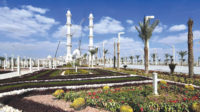Government
Egypt's Huge Capital Complex Rises East of Cairo

Development of phase 1 of the NAC will cost about $58 billion when complete in 2030. Basic infrastructure of the phase is complete, and construction on several buildings, including this ministerial building, is slated to be finished in 2022.
Photo courtesy Mohamed Abdalla
Egypt is in the midst of a huge construction boom—the center of which is a new capital development on 270 sq miles east of Cairo that is intended to modernize the seat of government for the country's 103 million people.
The Egyptian government announced in 2015 it would build the New Administrative Capital on land located between the main roads leading to the port cities of Suez and Ain El Sokhna. The urban complex will be home to up to 7 million people when complete in 2050, .
Designed by U.S.-based Skidmore Owings and Merrill, the complex consists of three phases, with the first phase set to cost about $58 billion when complete in 2030. Its basic infrastructure is complete, with construction of several buildings under way and set to be finished in 2022.
The city will host two towering skyscrapers. Work on an 80-floor tower, under construction for two years, has reached the 40th floor. When finished, it will be 385-m high, making it the tallest building in Egypt and Africa.
However, the planned Oblisco Capitale, which will look like a Pharaonic obelisk, is due to be inaugurated in 2030 at a height of 1,000 meters, making it the tallest structure in the world.
The Arab Contractors Co., also known as Osman Ahmed Osman Co., is completing the new parliament building, which so far has required 16.5 million work hours from 6,400 workers and 300 engineers.
Covering an area of 126,000 sq m, the building has 1,000 administrative offices and a 50-m-dia dome. Prime Minister Mostafa Madbouly said in April that about 52,000 government employees would begin transferring to work at the new complex in August.
Crews have used about 210,000 cu m of reinforced concrete and 25,000 cu m of reinforced steel in the project, said Ahmad El Aladalany, an Arab Contractors executive, in an emailed statement.
“We have had many challenges with this project,” Aladalany said, including COVID-19 and the removal of 500,000 cu m of rock and soil.
Multiple Phases
Phase 1 will establish the core of the new city and concentrate on essential needs for its operation. It covers development of 40,000 acres, including a government district, a commercial district and a downtown district built along the Green River.
Phase 2 will expand the city by 47,000 acres with more residential and business areas, and Phase 3 will add another 97,000 acres.
“You can imagine a city that stretches from the Nile River to the Red Sea,” Mohamed Abdalla, chairman of Coldwell Bank Middle East and vice chairman of Acumen Holding Investment Bank, told ENR. “We are witnessing something significant in the history of Egypt.”
The government is using proceeds from land sales at the new capital to finance the project, said Abdalla, also chairman of the real estate committee for AmCham Egypt, which promotes business between Egypt and the U.S. “We used to worry about investment, but that isn’t the case anymore… The government isn’t having to rely on foreign investors,” he said during an interview via Zoom.
The government also is collecting fees on construction that was previously done without licenses under earlier governments, he noted.
Virtually all of Egypt’s construction companies are involved in the new complex, as is China State Construction Engineering Corp.
Redcon Construction, another Egyptian builder, is working on district hotels, shopping malls, buildings in the central business district, a water-cooling plant for the ministerial district, a central park and a high-speed light rail station, said company Chairman Tarek El Ghamal.
Redcon has 3,000 employees engaged in its projects, with hundreds more employed by subcontractors. The contractor is active in 30 different projects throughout Egypt.
Egyptian companies are handling 70% to 80% of finishing for buildings and 40% of electrical-mechanical work, said Ghamal, who added that Redcon is also building the station for a high-speed light rail system that will connect the Red and Mediterranean Seas via the new complex and Cairo.
“Transportation will be the key to the [project's] success,” Ghamal told ENR.



